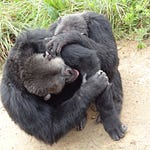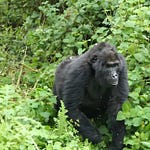In the miombo woodlands of Zambia, chimpanzees are doing something peculiar. They are not cracking nuts, fashioning spears, or fishing for termites. Instead, some have taken to sticking blades of grass in their ears. A few have gone further, placing them into their rectums. There is no obvious reason. It is not grooming. It is not foraging. It is not even attention-seeking. But it is spreading.
New research published in Behaviour1 (2025) documents how a small group of chimpanzees at the Chimfunshi Wildlife Orphanage Trust began participating in this strange fad. What began as one chimpanzee's idiosyncratic behavior quickly turned into a group-wide trend, copied and maintained through social learning. Like a high school fashion trend, the habit was picked up not for practical reasons but because everyone else seemed to be doing it.
The Original Trendsetter
The first known chimpanzee to pioneer the grass-in-ear phenomenon was Julie, a female living in Group 4 at Chimfunshi. Back in 2010, researchers watched as Julie repeatedly inserted a blade of grass into her ear, letting it dangle like an accessory. Within weeks, several others in her group began to imitate the act. Even after her death, a few group members kept up the tradition.
More than a decade later, in 2023, another group in the sanctuary independently began the same behavior. Juma, a male chimpanzee in Group 8, was first seen with grass hanging from his ear. Within a week, four others followed. And then came the twist: Juma took the trend further, inserting grass into his rectum, a behavior that became known as grass-in-rectum behavior (GIRB). As of early 2024, more than half the group had followed his lead.
"A Viral Trend by Means of Social Learning"
"Chimpanzees can socially learn novel skills and primarily use them in contexts of personal interest, like nut-cracking and termite fishing. Yet, when selection pressures relax, they may extend their social learning to behaviors without direct utility."
— Edwin van Leeuwen et al., 2025
The sanctuary’s researchers, led by Edwin van Leeuwen, used a statistical technique called Network-Based Diffusion Analysis to determine how the behavior spread. The results pointed overwhelmingly to social learning. Chimps weren’t discovering the behavior on their own; they were copying it from each other.

Importantly, none of the 136 chimpanzees in the other groups at Chimfunshi adopted the behavior. Only those in Juma’s group and two holdouts from Julie’s original cohort displayed either trend, reinforcing the idea that social connection, not function, drives these adoptions.
Copying Without Cause
What makes this study so compelling is its focus on non-instrumental behavior — actions with no clear adaptive or survival benefit. Unlike tool use, which helps chimps extract food or crack nuts, these grass-based habits serve no obvious purpose.

Social animals, including humans, often mimic others as a way of expressing connection or conformity. This could be part of what is happening in Group 8. Van Leeuwen and colleagues suggest that copying such arbitrary behaviors may help strengthen social cohesion, even if the actions themselves seem pointless.
"By copying someone else's behavior, you show that you notice and maybe even like that individual. So, it might help strengthen social bonds and create a sense of belonging."
— Edwin van Leeuwen
There are parallels in human behavior: from fashion to internet memes, people adopt behaviors that are socially transmitted but functionally arbitrary. Whether it’s skinny jeans or TikTok challenges, the desire to fit in, to belong, seems to be a shared primate impulse.
Captivity and Cultural Play
Chimpanzees in the wild are busy animals. They spend their days searching for food, defending territories, and navigating complex hierarchies. Captivity changes the tempo. Meals arrive on schedule. Predators are absent. Time becomes more abundant.
This leisure may create space for playful experimentation. Without the pressure of survival, chimpanzees can devote attention to social rituals or fads that might never emerge in the wild. Similar trends have been seen in other species: orcas sporting dead salmon as headwear, or dolphins mimicking human-trained tail-walking.
Cultural Transmission Without Tools
Traditions in animals have typically been associated with tool use. But this study adds to a growing body of research suggesting that animals also pass on arbitrary customs. Such findings challenge the notion that only humans engage in culture for culture’s sake.
That said, there is still debate over the mechanisms behind such learning. Do chimps truly imitate? Or are they responding to simple cues and social reinforcement? The researchers argue that the evidence here is best explained by social copying.
Moreover, the emergence of two separate grass-related behaviors in two different chimpanzee groups more than a decade apart suggests a degree of creative innovation — one that taps into a shared cognitive substrate in Pan troglodytes.
Looking Forward
What does it mean that chimpanzees stick grass in their ears and butts? On one level, perhaps not much. But in the bigger picture, these quirky traditions hint at deep roots in the primate brain for social learning, conformity, and group identity.
As van Leeuwen and colleagues put it, these behaviors could be "opportunistic expressions of the animals' latent capacity to copy behavior" — a kind of cultural play that, in some small way, mirrors the human urge to mimic, perform, and belong.
Related Research
van Leeuwen, E. J. C., Cronin, K. A., & Haun, D. B. M. (2014). A group-specific arbitrary tradition in chimpanzees (Pan troglodytes). Animal Cognition, 17(6), 1421–1425. https://doi.org/10.1007/s10071-014-0776-7
Perry, S., Baker, M., & Manson, J. H. (2003). Social conventions in wild white-faced capuchin monkeys: Evidence for traditions in a neotropical primate. Current Anthropology, 44(2), 241–268. https://doi.org/10.1086/345825
Goldsborough, Z., Webb, C. E., de Waal, F. B. M., & van Leeuwen, E. J. C. (2021). Zoo-housed female chimpanzee adopts local female-specific tradition upon immigrating into a new group. Behaviour, 158(6-7), 547–564. https://doi.org/10.1163/1568539X-bja10063
Bridges, A. D., Royka, A., & Chittka, L. (2024). Bumblebees socially learn behavior too complex to innovate alone. Nature, 627(7993), 572–578. https://doi.org/10.1038/s41586-024-07124-1
Boesch, C., et al. (2020). Chimpanzee ethnography reveals unexpected cultural diversity. Nature Human Behaviour, 4(9), 910–916. https://doi.org/10.1038/s41562-020-0883-1
van Leeuwen, E. J. C., Bryon, E., Rogers, A., Balaran, A., Motsch, P., & Brooker, J. S. (2025). Chimpanzees socially learn non-instrumental behaviour from conspecifics. Behaviour, 1(aop), 1–18. https://doi.org/10.1163/1568539x-bja10313










